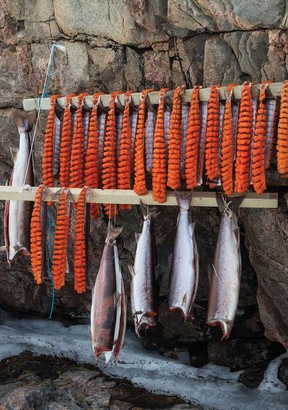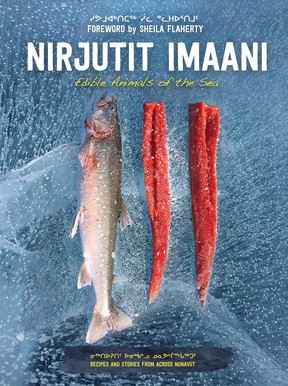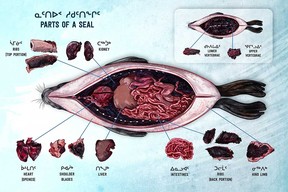Fish and seal cookbook cookbook from Nunavut showcases Inuit cuisine
‘In Nunavut, food is so much more than sustenance,’ Iqaluit chef Shelia Flaherty writes in Nirjutit Imaani: Cooking with Fish and Seal
Reviews and recommendations are unbiased and products are independently selected. Postmedia may earn an affiliate commission from purchases made through links on this page.
Article content
Our cookbook of the week is Nirjutit Imaani: Edible Animals of the Sea published by Nunavut Arctic College Media, with a foreword by Iqaluit chef Sheila Flaherty. To try a recipe from the book, check out: Turbot tacos, Arctic-char-in-a-bannock-blanket and Arctic char with Montreal steak spice.
Advertisement 2
Article content
In the Arctic city of Iqaluit, chef Sheila Flaherty lives close to the land, sea and ice. She and her husband, Johnny, lead a subsistence lifestyle. They have a boat, snowmobiles, all-terrain vehicles, qamutiik (sleds), a kakivak (leister, three-pronged fish spear) rifles of different calibres and a shotgun.
“We’re fully equipped, and we love going out on the land,” says Flaherty, having just reheated a bowl of caribou stew for lunch.
On their porch, there’s a batch of Arctic char drying for pipsi, scored in a checkerboard pattern and fixed to a hockey stick. The skin from her first seal is stored in their freezer, ready to be sewn into clothing — probably “a nice pair of mitts.”
Flaherty grew up in Ottawa. Even in the south, she had a sense of her Inuvialuk heritage through her late mother. When she moved to Iqaluit in 2010, though, the connection deepened.
Advertisement 3
Article content
“To actually live the culture, day in, day out, it’s a whole ‘nother level that that I’ve been afforded. And would I live anywhere else? No, I can’t,” says Flaherty.
“Every time we go out hunting and harvesting, it’s just breathtaking each time. It really does wonders for our souls. And it’s really humbling.”

Flaherty, who competed on MasterChef Canada in 2017, is executive chef of sijjakkut (Inuktitut for “by the seashore”). Now in its pilot phase, she and Johnny founded the culinary tourism company to promote and preserve Inuit culture through inuksiutit (country food, e.g., ringed seal, caribou and Arctic char).
When the Government of Nunavut asked her to write the foreword to Nirjutit Imaani: Edible Animals of the Sea, which won the Arctic category at the Gourmand World Cookbook Awards 2022, she was honoured to be involved.
Advertisement 4
Article content
“I tried to capture what food means to Inuit and how we’re intrinsically connected to our food,” says Flaherty.
Inuksiutit has sustained Inuit for millennia. “In Nunavut, food is so much more than sustenance. It holds a history of tradition, survival, medicine, storytelling, taste, place, and of providing for loved ones and neighbours,” Flaherty writes in Nirjutit Imaani. Though it has long provided a connection to land and sea, in past years, she has noticed a resurgence and pride among Nunavummiut for ways of preparing it, both traditional and new.

More than 40 people from all three regions of Nunavut (Qikiqtaaluk, Kivalliq and Kitikmeot) contributed Nirjutit Imaani‘s 56 recipes for fish and seal (and a few types of bannock). Recipes and stories of harvesting and hunting, preserving and sharing are presented in English and the Inuktut dialect and main orthography (syllabics or Roman) of the contributor’s community.
Advertisement 5
Article content
“Inuit Nunangat, our Inuit homeland, is so vast,” adds Flaherty. “So, to finally have a cookbook coming from Nunavummiut — from people who live in Nunavut and want to contribute their home recipes for our food — it’s really amazing.”
As Flaherty does with her food — such as the Arctic char sushi rolls she’s offering as part of sijjakkut’s pilot menu — Nunavummiut experiment with different ways of preparing inuksiutit. “There’s a real charm to the recipes, and it just gives me a sense of pride. There’s a real food culture in Nunavut, and (Nirjutit Imaani) exemplifies that.”
Mike Webster in Kugluktuk, for instance, shares a recipe for seal haggis: “After I heard about Inuit making food in the stomach, I thought, bingo — let’s make haggis!” Gwen Healey Akearok of the Qaujigiartiit Health Research Centre in Iqaluit uses turbot (a.k.a. Greenland halibut) to make biryani. Allen Uttuqiaq and Pokkuk Koplomik in Cambridge Bay contributed their Arctic-char-in-a-bannock-blanket, a circumpolar take on pigs in a blanket swapping hot dogs for char and premade dough for bannock.
Advertisement 6
Article content
These unique adaptations appear alongside snapshots of pipsi-making, instructions on how to ferment seal flipper and blubber, illustrations showing Inuit tools and cooking methods, the parts of a seal and techniques for preparing fish.
Flaherty appreciates this balance between traditional knowledge and contemporary home cooking. “I love it. It’s nice to see that I’m not the only Inuk who’s crazy passionate about our food,” she says, laughing.

For Nunavummiut, culinary creativity is often driven by necessity, Flaherty emphasizes. Having to make do with what’s available is a regular occurrence — not an occasional inconvenience. “It happens all the time where I want a particular ingredient and it’s just not possible. So, you have to be creative. You know, ‘How else can I prepare this dish that I want to make?’”
Advertisement 7
Article content
Food insecurity is on the rise in Canada (one in eight Canadians are food insecure, according to Statistics Canada). Nunavut has been hit especially hard with a rate more than eight times higher than the national average.
As Navalik Tologanak in Cambridge Bay recounts in Nirjutit Imaani: “When our hunters go out, they do the best they can to share. And sometimes it’s never enough. But we’re always thankful. And that’s the way the Inuit are. They share. So, you’re always thankful when you get a knock on the door, and (they) say, ‘I got you a fish. Here’s some caribou or here’s some seal or whatever.’ And we’re always thankful. And we hope that it’ll always continue, the sharing of country food …”
It’s expensive to go out on the land or the ocean, says Flaherty. Hunting and harvesting require gas, bullets, fishing hooks and “grub food” (packed nourishment for travel). “So, in that way, it’s somewhat inaccessible to some people, but we’ve always had access to our food — it was never denied to us as a people. But at the same time, even though it’s a part of us, there’s just an added sense of pride from people that I can see.”
During the pandemic, Nunavut Tunngavik Inc. hosted a Home Cook Challenge as part of their virtual Nunavut Day celebrations on July 9 (the day Parliament passed the Nunavut Land Claim Agreement in 1993).
As a judge, Flaherty experienced the passion Nunavummiut have for their food culture firsthand. “It’s just awesome to see people preparing our food in different ways. Or continuing to eat it traditionally, too. However you slice it, our food is delicious. People need to know about that.”
Advertisement
‘In Nunavut, food is so much more than sustenance,’ Iqaluit chef Shelia Flaherty writes in Nirjutit Imaani: Cooking with Fish and Seal

Reviews and recommendations are unbiased and products are independently selected. Postmedia may earn an affiliate commission from purchases made through links on this page.
Article content
Our cookbook of the week is Nirjutit Imaani: Edible Animals of the Sea published by Nunavut Arctic College Media, with a foreword by Iqaluit chef Sheila Flaherty. To try a recipe from the book, check out: Turbot tacos, Arctic-char-in-a-bannock-blanket and Arctic char with Montreal steak spice.
Advertisement 2
Article content
In the Arctic city of Iqaluit, chef Sheila Flaherty lives close to the land, sea and ice. She and her husband, Johnny, lead a subsistence lifestyle. They have a boat, snowmobiles, all-terrain vehicles, qamutiik (sleds), a kakivak (leister, three-pronged fish spear) rifles of different calibres and a shotgun.
“We’re fully equipped, and we love going out on the land,” says Flaherty, having just reheated a bowl of caribou stew for lunch.
On their porch, there’s a batch of Arctic char drying for pipsi, scored in a checkerboard pattern and fixed to a hockey stick. The skin from her first seal is stored in their freezer, ready to be sewn into clothing — probably “a nice pair of mitts.”
Flaherty grew up in Ottawa. Even in the south, she had a sense of her Inuvialuk heritage through her late mother. When she moved to Iqaluit in 2010, though, the connection deepened.
Advertisement 3
Article content
“To actually live the culture, day in, day out, it’s a whole ‘nother level that that I’ve been afforded. And would I live anywhere else? No, I can’t,” says Flaherty.
“Every time we go out hunting and harvesting, it’s just breathtaking each time. It really does wonders for our souls. And it’s really humbling.”

Flaherty, who competed on MasterChef Canada in 2017, is executive chef of sijjakkut (Inuktitut for “by the seashore”). Now in its pilot phase, she and Johnny founded the culinary tourism company to promote and preserve Inuit culture through inuksiutit (country food, e.g., ringed seal, caribou and Arctic char).
When the Government of Nunavut asked her to write the foreword to Nirjutit Imaani: Edible Animals of the Sea, which won the Arctic category at the Gourmand World Cookbook Awards 2022, she was honoured to be involved.
Advertisement 4
Article content
“I tried to capture what food means to Inuit and how we’re intrinsically connected to our food,” says Flaherty.
Inuksiutit has sustained Inuit for millennia. “In Nunavut, food is so much more than sustenance. It holds a history of tradition, survival, medicine, storytelling, taste, place, and of providing for loved ones and neighbours,” Flaherty writes in Nirjutit Imaani. Though it has long provided a connection to land and sea, in past years, she has noticed a resurgence and pride among Nunavummiut for ways of preparing it, both traditional and new.

More than 40 people from all three regions of Nunavut (Qikiqtaaluk, Kivalliq and Kitikmeot) contributed Nirjutit Imaani‘s 56 recipes for fish and seal (and a few types of bannock). Recipes and stories of harvesting and hunting, preserving and sharing are presented in English and the Inuktut dialect and main orthography (syllabics or Roman) of the contributor’s community.
Advertisement 5
Article content
“Inuit Nunangat, our Inuit homeland, is so vast,” adds Flaherty. “So, to finally have a cookbook coming from Nunavummiut — from people who live in Nunavut and want to contribute their home recipes for our food — it’s really amazing.”
As Flaherty does with her food — such as the Arctic char sushi rolls she’s offering as part of sijjakkut’s pilot menu — Nunavummiut experiment with different ways of preparing inuksiutit. “There’s a real charm to the recipes, and it just gives me a sense of pride. There’s a real food culture in Nunavut, and (Nirjutit Imaani) exemplifies that.”
Mike Webster in Kugluktuk, for instance, shares a recipe for seal haggis: “After I heard about Inuit making food in the stomach, I thought, bingo — let’s make haggis!” Gwen Healey Akearok of the Qaujigiartiit Health Research Centre in Iqaluit uses turbot (a.k.a. Greenland halibut) to make biryani. Allen Uttuqiaq and Pokkuk Koplomik in Cambridge Bay contributed their Arctic-char-in-a-bannock-blanket, a circumpolar take on pigs in a blanket swapping hot dogs for char and premade dough for bannock.
Advertisement 6
Article content
These unique adaptations appear alongside snapshots of pipsi-making, instructions on how to ferment seal flipper and blubber, illustrations showing Inuit tools and cooking methods, the parts of a seal and techniques for preparing fish.
Flaherty appreciates this balance between traditional knowledge and contemporary home cooking. “I love it. It’s nice to see that I’m not the only Inuk who’s crazy passionate about our food,” she says, laughing.

For Nunavummiut, culinary creativity is often driven by necessity, Flaherty emphasizes. Having to make do with what’s available is a regular occurrence — not an occasional inconvenience. “It happens all the time where I want a particular ingredient and it’s just not possible. So, you have to be creative. You know, ‘How else can I prepare this dish that I want to make?’”
Advertisement 7
Article content
Food insecurity is on the rise in Canada (one in eight Canadians are food insecure, according to Statistics Canada). Nunavut has been hit especially hard with a rate more than eight times higher than the national average.
As Navalik Tologanak in Cambridge Bay recounts in Nirjutit Imaani: “When our hunters go out, they do the best they can to share. And sometimes it’s never enough. But we’re always thankful. And that’s the way the Inuit are. They share. So, you’re always thankful when you get a knock on the door, and (they) say, ‘I got you a fish. Here’s some caribou or here’s some seal or whatever.’ And we’re always thankful. And we hope that it’ll always continue, the sharing of country food …”
It’s expensive to go out on the land or the ocean, says Flaherty. Hunting and harvesting require gas, bullets, fishing hooks and “grub food” (packed nourishment for travel). “So, in that way, it’s somewhat inaccessible to some people, but we’ve always had access to our food — it was never denied to us as a people. But at the same time, even though it’s a part of us, there’s just an added sense of pride from people that I can see.”
During the pandemic, Nunavut Tunngavik Inc. hosted a Home Cook Challenge as part of their virtual Nunavut Day celebrations on July 9 (the day Parliament passed the Nunavut Land Claim Agreement in 1993).
As a judge, Flaherty experienced the passion Nunavummiut have for their food culture firsthand. “It’s just awesome to see people preparing our food in different ways. Or continuing to eat it traditionally, too. However you slice it, our food is delicious. People need to know about that.”

